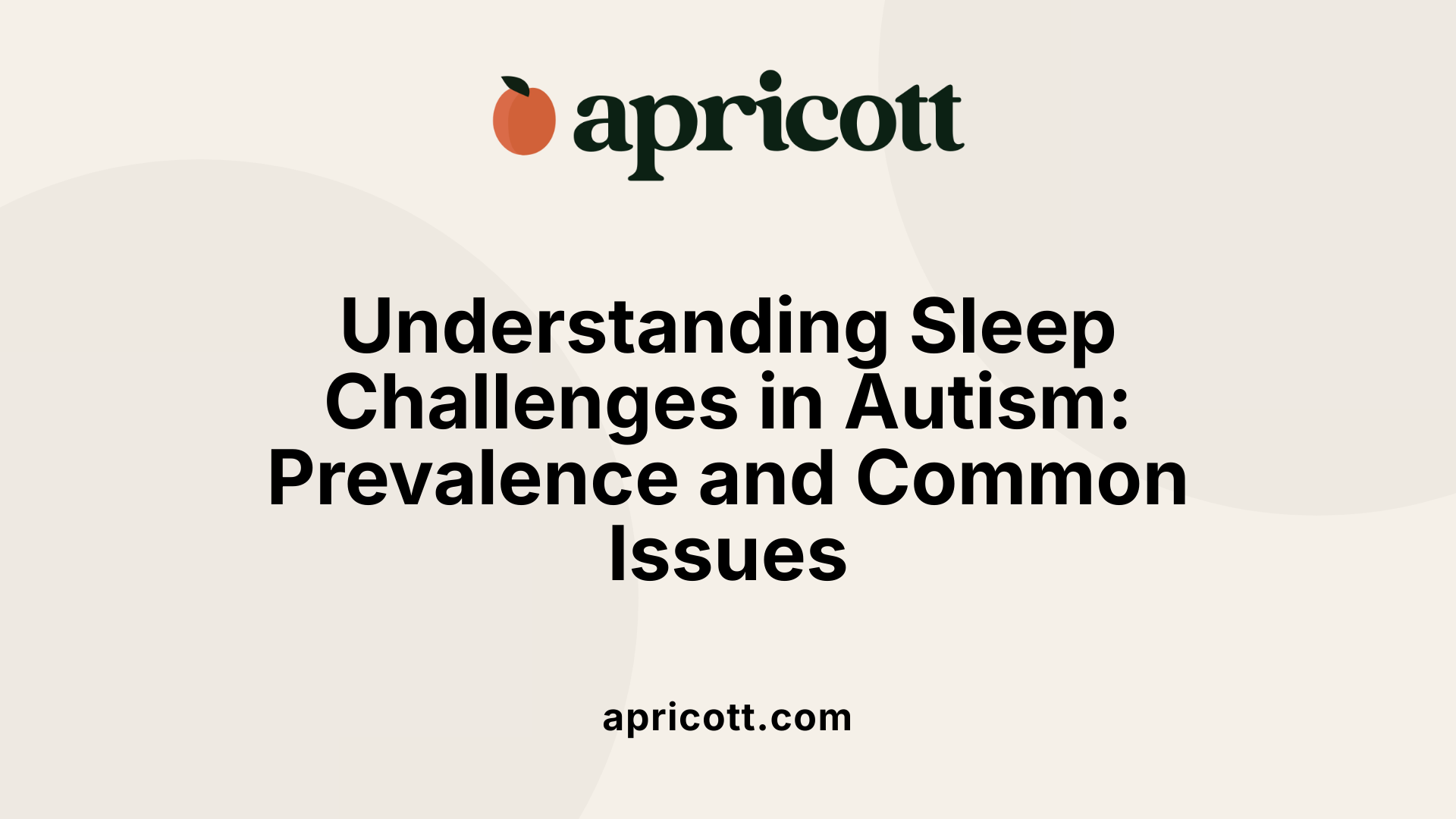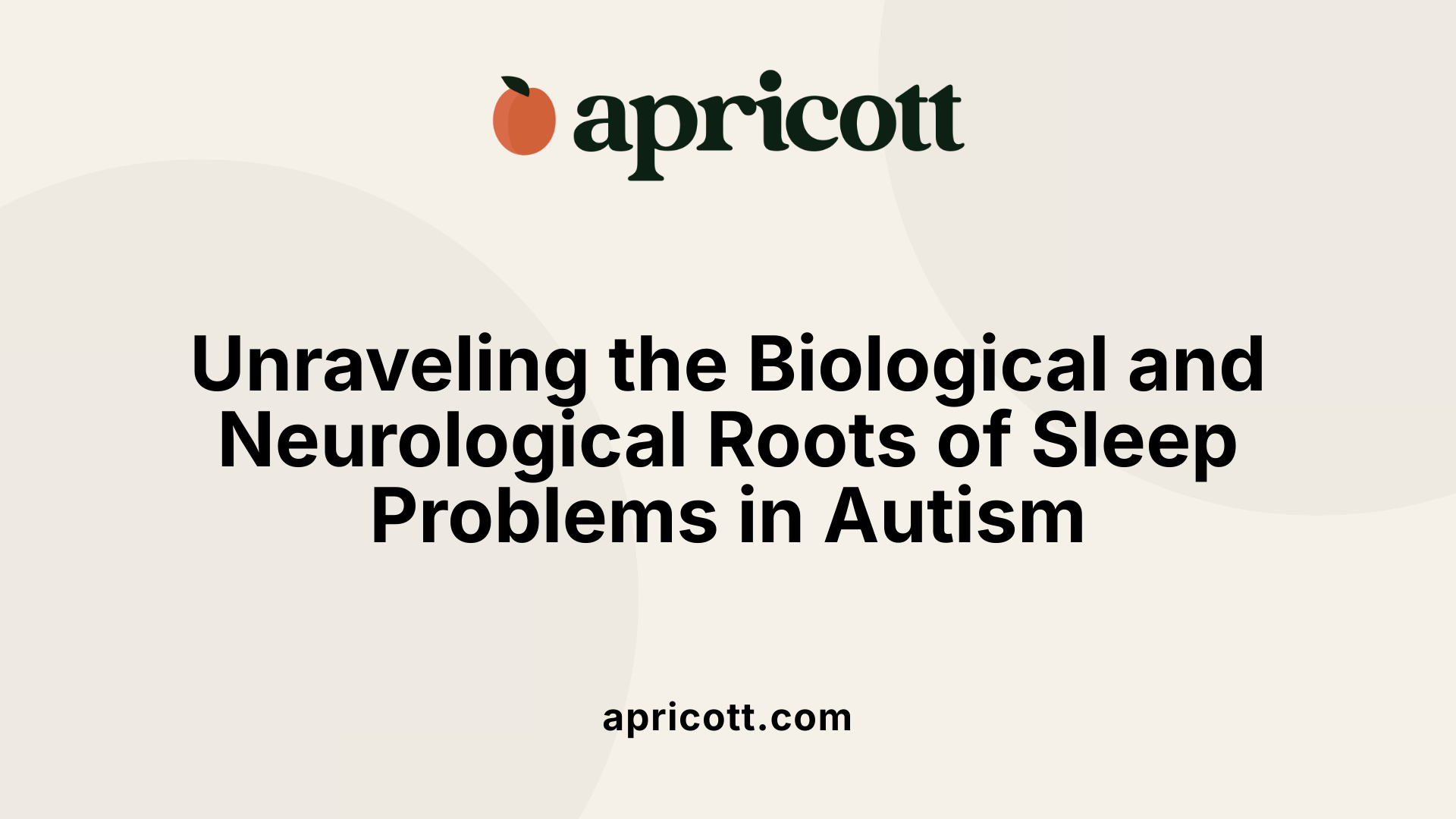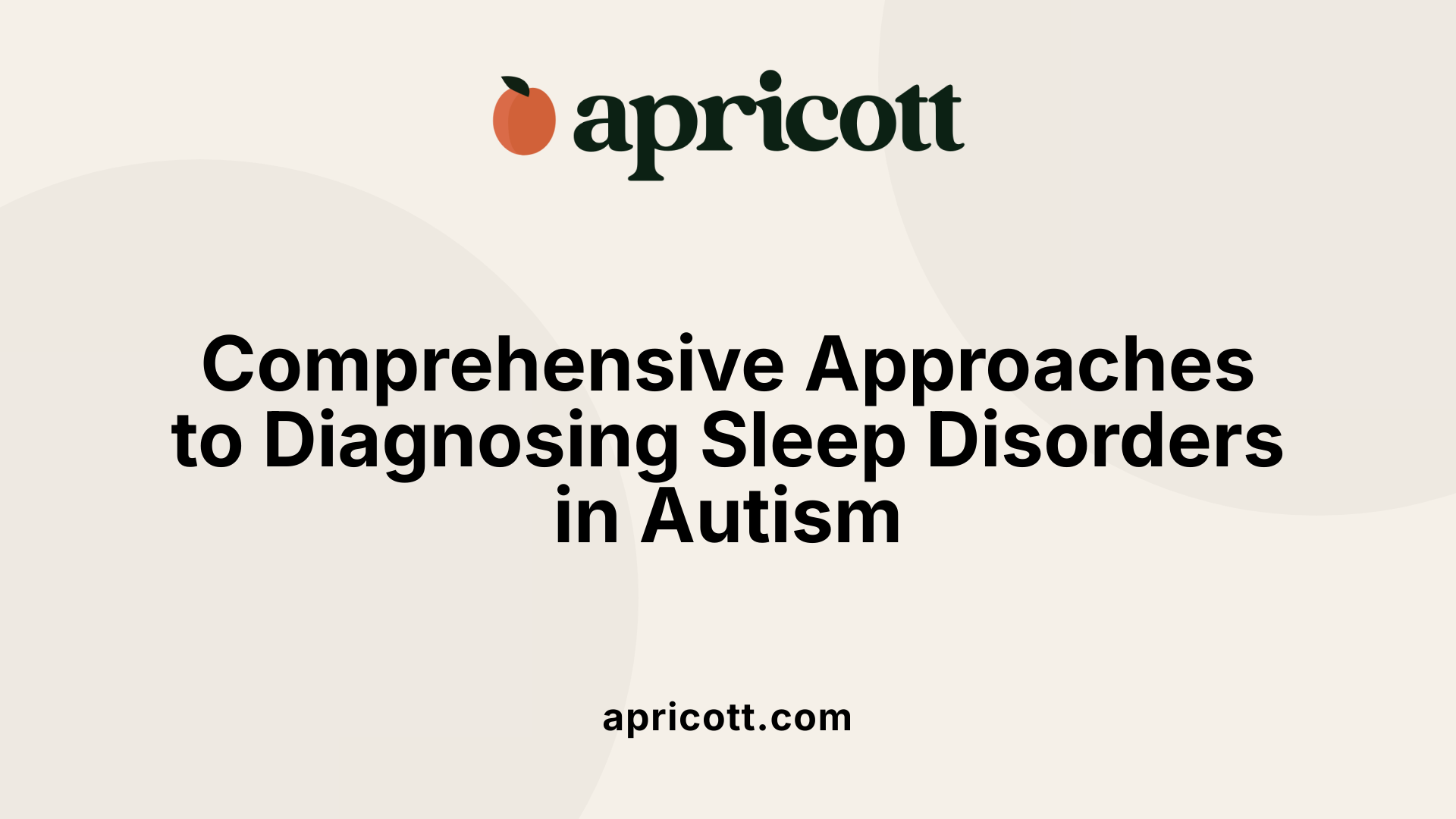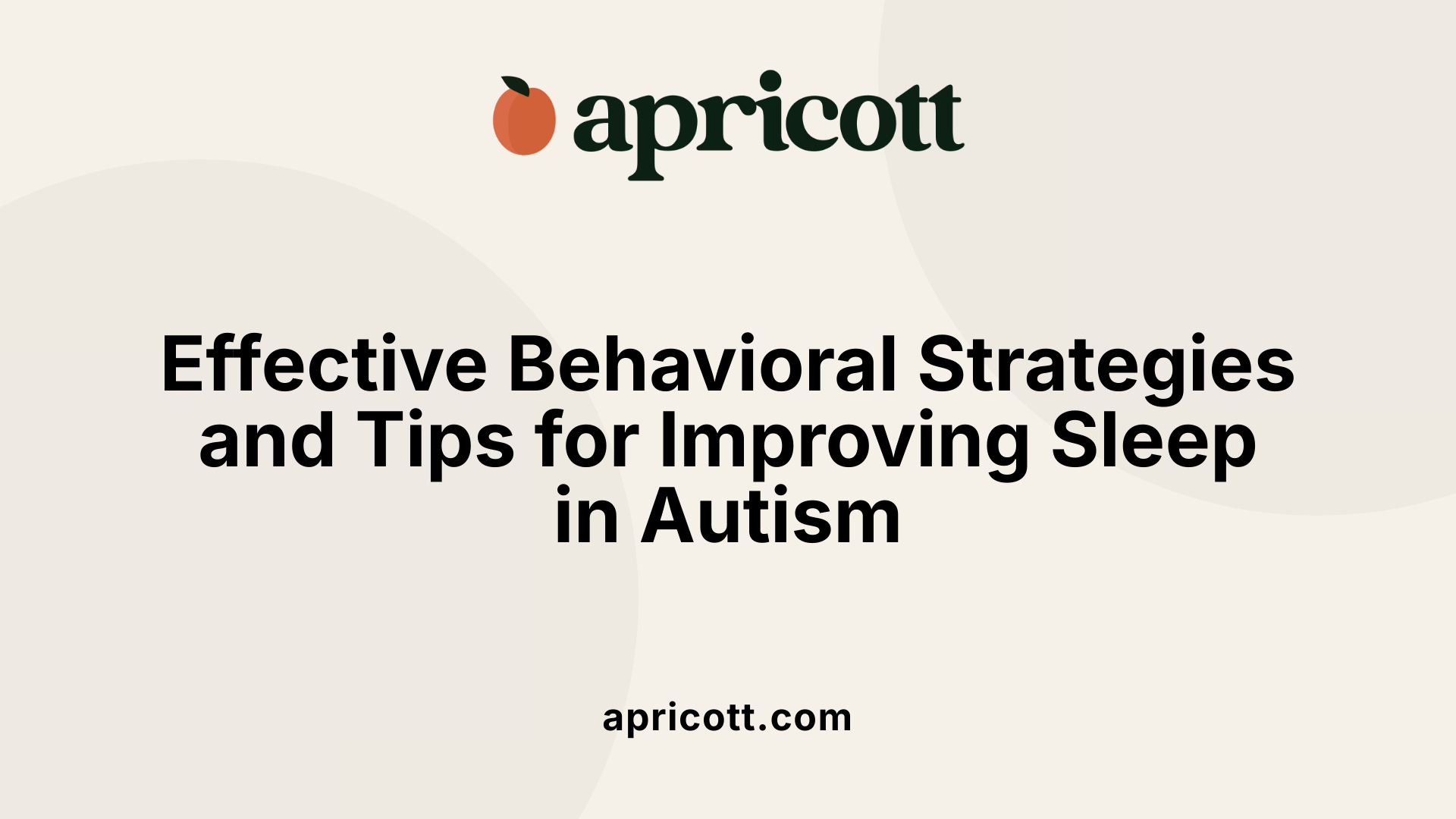An In-Depth Look at Sleep Challenges in the Autism Spectrum
Sleep difficulties are highly prevalent among individuals with autism spectrum disorder (ASD), affecting as many as 80%. These challenges extend across childhood into adulthood, impacting health, behavior, and overall quality of life. This article explores the underlying causes, assessment methods, management strategies, and educational resources related to sleep issues in autism, aiming to provide caregivers, practitioners, and individuals with a comprehensive understanding of this complex subject.
Prevalence and Types of Sleep Problems in Autism
 Many children and adults on the autism spectrum face persistent sleep challenges, with estimates indicating that between 40% and 80% experience significant difficulties. These issues often include trouble falling asleep, frequent awakenings during the night, early morning waking, and generally reduced sleep duration.
Many children and adults on the autism spectrum face persistent sleep challenges, with estimates indicating that between 40% and 80% experience significant difficulties. These issues often include trouble falling asleep, frequent awakenings during the night, early morning waking, and generally reduced sleep duration.
Research shows that sleep architecture in autistic individuals differs from neurotypical patterns. Abnormalities such as diminished REM sleep, increased sleep onset latency, and irregular sleep cycles are common. These disturbances are linked to irregular melatonin production and disruptions in circadian rhythms, which are the body's natural sleep-wake cycles.
Autistic people are also more prone to parasomnias like sleepwalking, sleep paralysis, and night terrors. Additionally, sleep-disordered breathing conditions like sleep apnea are notable concerns in this population. These varied sleep problems can worsen behavioral issues, increase sensory sensitivities, and negatively affect learning, mood, and social skills.
Impacts extend beyond the individual to their families, often heightening parental stress and disrupting daily routines. To address these issues, interventions typically focus on behavioral strategies—such as establishing consistent bedtime routines, optimizing the sleep environment, and managing sensory sensitivities—alongside medical treatments like melatonin supplements.
| Aspect | Description | Additional Notes |
|---|---|---|
| Common sleep problems | Difficulty falling asleep, frequent night awakenings, early waking | Often linked to melatonin irregularities and circadian issues |
| Sleep architecture changes | Decreased REM sleep, increased sleep latency | Affects memory, learning, and emotional regulation |
| Parasomnias | Sleepwalking, night terrors, sleep paralysis | More prevalent in autistic individuals |
| Associated conditions | Sleep apnea, restless legs syndrome, gastrointestinal issues | Can exacerbate sleep problems |
Understanding the prevalence and predominant types of sleep disturbances emphasizes the importance of tailored assessments and interventions for autistic individuals. Addressing these ISSUES can significantly improve quality of life and reduce behavioral challenges.
Neurological and Biological Bases of Sleep Issues in Autism

What causes sleep disturbances in autism?
Sleep disturbances in autism stem from a complex mix of biological, neurological, behavioral, and environmental factors. One primary biological factor involves irregularities in melatonin production. Many autistic individuals exhibit lower melatonin levels and disruptions in circadian rhythms, which are the body's internal clock regulating sleep-wake cycles. This leads to difficulties in falling asleep and maintaining sleep.
Neurologically, differences in brain structure and function also contribute. Alterations in GABAergic interneurons and abnormalities in sleep architecture—such as reduced REM sleep—disrupt the restorative quality of sleep. Sensory sensitivities, including responses to sound, light, or touch, can further interfere with sleep routines, especially when combined with common co-occurring conditions like anxiety or sleep apnea.
Behavioral aspects, like irregular bedtime routines and excessive use of electronic devices, worsen sleep issues. Environmental factors, including noise, light, and environmental instability, also play roles. Health factors such as gastrointestinal problems or seizures may exacerbate the inability to sleep comfortably.
To tackle these challenges, interventions often involve melatonin supplements, sleep hygiene practices, and behavioral therapies aimed at establishing consistent sleep routines.
Are genetic factors involved in sleep issues among autistic individuals?
Genetic factors significantly influence sleep difficulties in autism. Many autistic people carry mutations in genes responsible for regulating sleep and circadian rhythms. For instance, mutations affecting the synthesis of melatonin—a hormone essential for sleep regulation—result in a 'flat melatonin curve.' This abnormal pattern impairs tiredness cues and sleep initiation.
Furthermore, some individuals have mutations in the CLOCK gene, which is crucial for maintaining the body's circadian rhythm. These genetic alterations contribute to irregular sleep-wake cycles commonly observed in autism.
Research, including twin studies, supports a shared genetic basis for both ASD and sleep problems. This suggests that inherited genetic variations predispose autistic individuals to disrupted sleep patterns, highlighting the importance of considering genetics when diagnosing and treating sleep issues.
| Aspect | Description | Impact |
|---|---|---|
| Melatonin Production | Lower levels and disrupted regulation in autism | Difficulties with sleep onset and maintenance |
| Genetic Mutations | Mutations in melatonin-regulating genes and CLOCK gene | Irregular circadian rhythms, altered sleep-wake cycles |
| Brain Structure & Function | Abnormalities in sleep architecture and neural circuits | Reduced REM sleep, poor sleep quality |
| Environmental & Behavioral Factors | Noise sensitivity, routine irregularity, screen time | Further sleep disruptions |
Understanding these biological and genetic underpinnings helps refine treatment approaches, such as targeted pharmacotherapy and behavioral interventions, to improve sleep health in autistic populations.
Assessment and Diagnosis of Sleep Problems in Autism
 Understanding and addressing sleep issues in autistic individuals requires a comprehensive assessment approach that combines subjective reports and objective measurements.
Understanding and addressing sleep issues in autistic individuals requires a comprehensive assessment approach that combines subjective reports and objective measurements.
In terms of subjective evaluation, healthcare providers often rely on parental questionnaires and sleep diaries. Tools like the Children’s Sleep Habit Questionnaire (CSHQ) allow parents to report on their child's sleep patterns, difficulties, and routines. Sleep diaries, maintained over several nights, provide detailed insights into sleep timing, duration, night awakenings, and behaviors that may contribute to sleep problems.
Objective assessments include advanced tools like actigraphy, a non-invasive method that uses wrist-worn devices to monitor sleep-wake activity continuously. This digital tracking provides data on sleep onset, total sleep time, and nocturnal awakenings, helping to visualize sleep patterns in real-world settings.
Polysomnography stands out as the most detailed and comprehensive sleep study method. It involves recording brain activity through EEG, eye movements, muscle activity, heart rhythm, and breathing patterns during sleep. Although it offers invaluable insights into sleep architecture and possible disorders like sleep apnea or restless legs syndrome, conducting polysomnography can be challenging in children with autism due to sensory sensitivities and comfort issues.
Videosomnography presents an alternative, offering visual recordings of sleep behaviors within the home environment. This method captures behaviors related to sleep resistance, movements, and other disturbances without the need for sleep lab settings.
A thorough investigation also includes medical evaluations to uncover underlying health or sensory issues that might affect sleep. Conditions such as sleep apnea, gastrointestinal disturbances, or sensory processing differences are considered.
By combining caregiver reports, objective measurements, and medical assessments, clinicians can more accurately diagnose sleep disturbances. This comprehensive approach ensures that interventions can be tailored effectively, addressing specific problems like insomnia, circadian rhythm disorders, or sleep-related sensory sensitivities, ultimately improving overall well-being.
Practical Strategies and Behavioral Interventions

What practical tips can help improve sleep in autistic children and adults?
Improving sleep for individuals with autism involves a combination of environmental adjustments and routine development. Establishing a predictable, calming bedtime routine using visual cues or social stories can significantly reduce anxiety about sleep. Maintaining a consistent sleep schedule, even on weekends, helps regulate the body’s internal clock.
Creating a sleep-friendly environment is crucial. A room that is dark, quiet, and cool—around 65–67°F—supports better rest. Using soothing fabrics, blackout curtains, and minimizing sensory stimulation can prevent overstimulation that hinders sleep. Relaxation techniques like deep breathing, massage, or soft music before bed can further ease the transition into sleep.
Sensation management is also beneficial; weighted blankets, compression sheets, or gentle massage may provide comfort and reduce sensory overload. Limiting screen time before bed is important, as exposure to blue light can interfere with melatonin production, which regulates sleep. Managing noise levels at home and avoiding stimulants like caffeine helps in establishing a calm sleep environment.
In some cases, healthcare providers recommend melatonin supplements, which have been shown to improve sleep onset and duration when used appropriately. Promoting daytime physical activity and gradually teaching independent sleep skills are additional strategies to foster healthier sleep patterns.
Are behavioral interventions effective for sleep problems in autism?
Yes, behavioral interventions are considered effective in addressing sleep difficulties in autistic individuals. These strategies focus on creating a structured, predictable environment and routine that reduces bedtime anxiety and resistance.
Techniques such as cueing with visual supports, positive reinforcement for successful sleep, and stimulus fading (gradually decreasing sensory input like sound or light) help establish healthy sleep habits. Scheduled awakenings are also used to manage night terrors or sleep resistance.
Consistency is vital for success; interventions often combine environmental modifications with behavioral strategies for best outcomes. When combined with medical or pharmacological approaches like melatonin, these interventions can improve sleep quality significantly.
Overall, behavioral methods empower caregivers and individuals to attain better sleep hygiene, easing behavioral challenges associated with sleep struggles and leading to improved overall wellbeing.
Pharmacological and Medical Treatments for Sleep Issues

What management and treatment options are available for sleep problems in autism?
Managing sleep disturbances in children and adults with autism involves a combination of behavioral, environmental, pharmacological, and medical strategies. Behavioral interventions are often the first approach and include establishing predictable bedtime routines, maintaining a sleep-friendly environment that is dark, cool, and quiet, and implementing sleep hygiene practices such as avoiding screen time before bed and limiting caffeine intake.
Specific techniques like cueing and positive reinforcement can encourage healthy sleep habits. Stimulus fading, scheduled awakenings during night terrors, and sleep training are additional methods used to help children fall asleep and remain asleep longer. Alongside these, addressing underlying medical conditions—such as sleep apnea, sensory sensitivities, or gastrointestinal issues—is vital because these can interfere with sleep and exacerbate behavioral problems.
For some individuals, medication can support these behavioral strategies. The most common pharmacological treatment for sleep problems in autism is melatonin, which has been shown to improve sleep onset, duration, and efficiency. In certain cases, medications like clonidine and other alpha-adrenergic agonists may be prescribed to help initiate and sustain sleep. While medications like atypical antipsychotics are sometimes used, they are generally not first-line treatments for sleep issues alone.
Combining behavioral management with medical interventions provides a comprehensive approach that can substantially improve sleep quality, reduce behavioral challenges linked to poor sleep, and enhance overall quality of life for individuals with autism.
Are medications like melatonin safe and effective?
Melatonin is widely recognized as a safe and effective option for managing sleep problems in autistic individuals. Studies have demonstrated its ability to reduce the time it takes to fall asleep (sleep latency), increase total sleep time, and improve overall sleep efficiency. Typical dosages range from 3 to 10 mg taken about 30-60 minutes before bedtime.
The safety profile of melatonin is favorable, with mild side effects like dizziness or headaches being rare when used at appropriate doses under medical guidance. Because of its natural role in regulating sleep-wake cycles, melatonin is often considered a first-choice pharmacological treatment.
Other medications such as antihistamines, antidepressants, or medications like guanfacine and clonidine may be used selectively, especially for co-occurring conditions or specific sleep issues, but they require careful medical supervision due to potential side effects and limited evidence in the autism population.
Overall, melatonin offers a reliable and generally well-tolerated option that can significantly assist in establishing and maintaining healthy sleep patterns in children and adults with autism.
Medical Conditions Affecting Sleep in Autism
What medical conditions can cause or exacerbate sleep problems in autistic individuals?
Children and adults on the autism spectrum frequently face medical conditions that can worsen their sleep difficulties. One prominent condition is obstructive sleep apnea, which involves loud snoring, pauses in breathing during sleep, and restless nights. This disorder often results in excessive daytime sleepiness and can severely impact overall sleep quality.
Gastroesophageal reflux disease (GERD) is another condition that can interfere with restful sleep. Reflux symptoms may cause discomfort and waking during the night, further disrupting sleep cycles.
Seizures are also common among autistic individuals and can occur during sleep, leading to disturbances or awakenings. Managing epilepsy with appropriate medication can sometimes improve sleep patterns.
Additionally, sensory sensitivities—such as heightened responses to sound, light, or touch—can make falling asleep or staying asleep difficult. Over-stimulation from the environment can override natural sleep cues and create resistance to bedtime.
Recognizing these underlying health issues is vital. Medical interventions like the use of continuous positive airway pressure (CPAP) for sleep apnea or targeted treatments for reflux can significantly improve sleep outcomes.
Addressing these health conditions as part of a broader sleep management plan helps ensure better sleep hygiene, reduces behavioral issues related to poor sleep, and enhances overall quality of life for autistic individuals.
Educational Resources and Supports for Sleep Challenges in Autism
Are there educational resources available about sleep difficulties associated with autism?
Yes, a wide range of educational resources exist to support individuals and caregivers dealing with sleep problems in autism. Reputable organizations such as the Autism Treatment Network (ATN) offer comprehensive guides rooted in scientific research. These resources provide practical strategies, including establishing consistent routines, optimizing the sleep environment, and addressing sensory sensitivities that often interfere with sleep.
Many guides also cover behavioral interventions, such as sleep training and environmental adjustments, alongside medical options like melatonin supplementation. Additionally, downloadable tools like strategy kits, fact sheets, and checklists are available to help families implement effective sleep routines.
Caregivers can access educational materials that detail how to monitor sleep patterns, recognize signs of sleep disorders like sleep apnea, and understand when to seek medical advice. These resources aim to empower families with knowledge, reducing anxiety around sleep issues and fostering healthier sleep habits for both children and adults with autism.
Overall, these educational supports serve as valuable tools to enhance sleep quality, contribute to better behavioral outcomes, and improve overall quality of life for autistic individuals.
Summary and Future Directions
The importance of personalized approaches
Given the complex relationship between autism and sleep disturbances, there is a growing consensus that treatment must be tailored to each individual. Factors such as the child's specific sleep issues, co-occurring conditions, genetic factors, and family environment all influence the most effective strategies. Personalized plans might include combining behavioral interventions with medication like melatonin, environmental modifications, and addressing any underlying medical issues such as sleep apnea or gastrointestinal discomfort.
Ongoing research and potential innovations
Research by organizations like Autism Speaks and various academic institutions continues to deepen our understanding of the biological and genetic roots of sleep problems in autism. Studies examining sleep EEG microstructure, genetic mutations affecting melatonin production, and circadian rhythm abnormalities are paving the way for targeted therapies. Future innovations might involve advanced genetic testing, personalized medicine approaches, and new pharmacological agents designed to normalize sleep patterns more effectively.
The role of education and multidisciplinary care
Raising awareness among parents, caregivers, and healthcare providers remains crucial. Education about sleep hygiene and management strategies can empower families to implement effective routines. Multidisciplinary teams—including neurologists, psychologists, sleep specialists, and occupational therapists—are essential for comprehensive care. Such collaboration ensures that treatments address both sleep issues and the broader spectrum of challenges faced by autistic individuals, ultimately aiming to improve quality of life and developmental outcomes.
| Aspect | Current Focus | Future Outlook | Importance |
|---|---|---|---|
| Personalized Treatment | Behavioral strategies, melatonin, environmental adjustments | Genetic profiling, customized medications | Tailors care to individual needs for better outcomes |
| Research and Innovation | Sleep EEG, genetic studies | Advanced therapeutics, gene therapy | Deepens understanding and enhances treatment options |
| Education & Care | Parental guidance, sleep routines | Increased awareness, multidisciplinary approaches | Supports long-term management and overall well-being |
Moving Toward Better Sleep and Well-Being
Understanding and addressing sleep problems in autism require a multifaceted approach that combines behavioral, medical, and environmental strategies tailored to each individual. Ongoing research continues to uncover genetic and neurobiological underpinnings, promising more effective treatments in the future. Education, caregiver support, and multidisciplinary care are vital to optimize sleep health, ultimately enhancing the quality of life for autistic individuals and their families.
References
- Sleep
- Autism and sleep disorders - PMC
- Autism and Sleep Issues | Why Sleep Is Hard for Many ...
- Interventions | Center for Sleep in Autism Spectrum Disorder
- Treating Sleep Disorders
- Autism and Sleep Issues
- The relationship between autism spectrum disorder and ...
- Sleep problems in autism, explained
- Interventions | Center for Sleep in Autism Spectrum Disorder
- Pharmacological Approach to Sleep Disturbances in Autism ...
.svg)
.svg)








